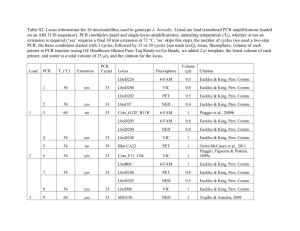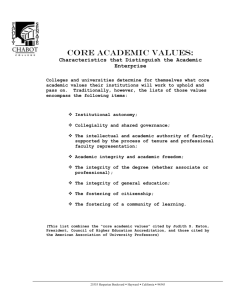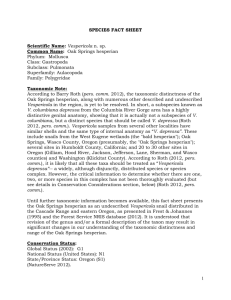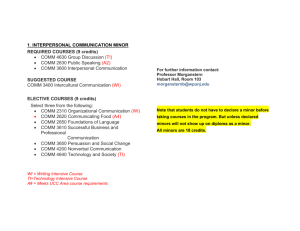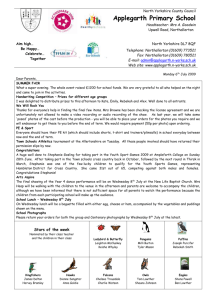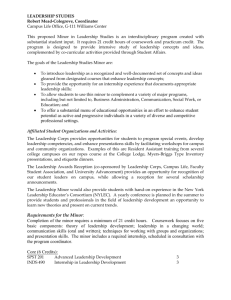Vespericola n. sp., Bald Hesperian
advertisement
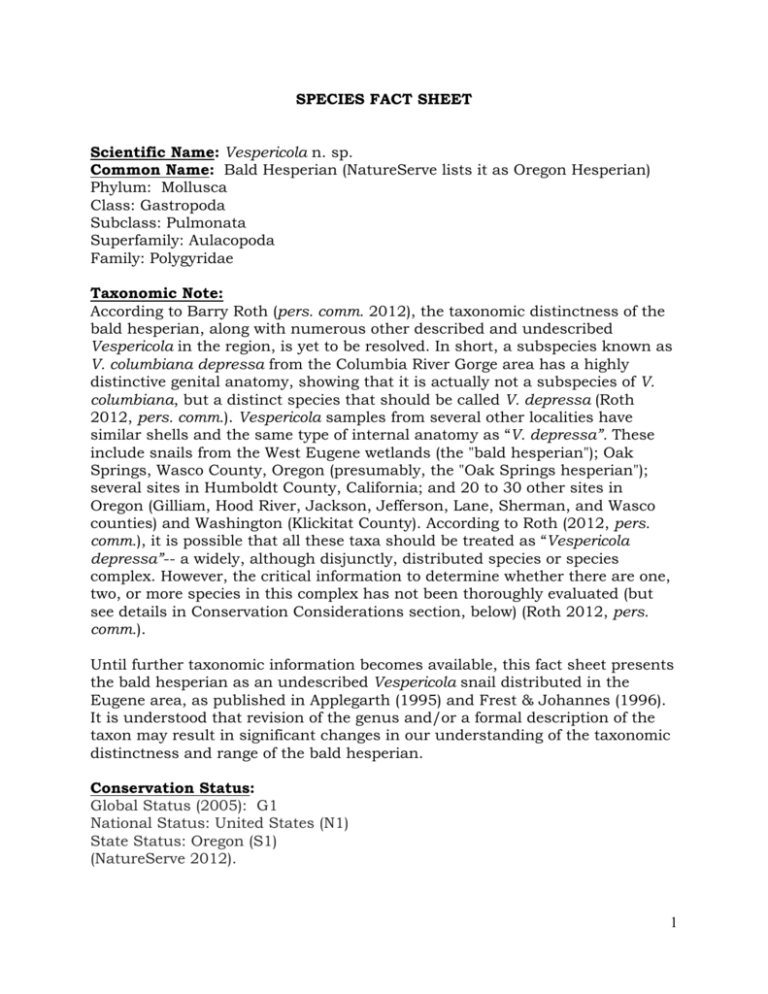
SPECIES FACT SHEET Scientific Name: Vespericola n. sp. Common Name: Bald Hesperian (NatureServe lists it as Oregon Hesperian) Phylum: Mollusca Class: Gastropoda Subclass: Pulmonata Superfamily: Aulacopoda Family: Polygyridae Taxonomic Note: According to Barry Roth (pers. comm. 2012), the taxonomic distinctness of the bald hesperian, along with numerous other described and undescribed Vespericola in the region, is yet to be resolved. In short, a subspecies known as V. columbiana depressa from the Columbia River Gorge area has a highly distinctive genital anatomy, showing that it is actually not a subspecies of V. columbiana, but a distinct species that should be called V. depressa (Roth 2012, pers. comm.). Vespericola samples from several other localities have similar shells and the same type of internal anatomy as “V. depressa”. These include snails from the West Eugene wetlands (the "bald hesperian"); Oak Springs, Wasco County, Oregon (presumably, the "Oak Springs hesperian"); several sites in Humboldt County, California; and 20 to 30 other sites in Oregon (Gilliam, Hood River, Jackson, Jefferson, Lane, Sherman, and Wasco counties) and Washington (Klickitat County). According to Roth (2012, pers. comm.), it is possible that all these taxa should be treated as “Vespericola depressa”-- a widely, although disjunctly, distributed species or species complex. However, the critical information to determine whether there are one, two, or more species in this complex has not been thoroughly evaluated (but see details in Conservation Considerations section, below) (Roth 2012, pers. comm.). Until further taxonomic information becomes available, this fact sheet presents the bald hesperian as an undescribed Vespericola snail distributed in the Eugene area, as published in Applegarth (1995) and Frest & Johannes (1996). It is understood that revision of the genus and/or a formal description of the taxon may result in significant changes in our understanding of the taxonomic distinctness and range of the bald hesperian. Conservation Status: Global Status (2005): G1 National Status: United States (N1) State Status: Oregon (S1) (NatureServe 2012). 1 The Oregon Biodiversity Information Center (ORBIC, 2010) refers to this species as the Bald Hesperian and ranks this species as List 1. Technical Description: The bald hesperian is a pulmonate (air-breathing) land snail in the family Polygyridae. This family is comprised of small to large sized snails with well reflected lip margins and often with apertural teeth (Burke & Leonard 2009, draft). The shells of many species in this family are adorned with periostracal hairs, although the hairs are lost by adulthood in most species (Burke & Leonard 2009, draft). Five genera occur in the Pacific Northwest: Allogona, Cryptomastix, Hochbergellus, Trilobopsis, and Vespericola. Of these, the genus Vespericola is characterized by having shells of a distinctive and fairly uniform shape: the body whorl is rather capacious, the spire is moderately elevated and generally conic, and there is usually a distinct constriction just before the reflected lip margin. The northern species are usually without dentition, but some species from southwestern Washington and farther south have a parietal tooth or lamella. The shell is thin and fragile; the umbilicus is perforate to very narrowly umbilicate. Most are adorned with periostracal hairs (seldom lacking) of varying size and density. A similar genus, Hochbergellus, is indistinguishable from Vespericola by external characteristics (Burke & Leonard 2009, draft). Within the Vespericola genus, general shell characteristics are so similar that species-level identification from shells alone can be difficult or impossible, and dissection is necessary for positive identification of the species (Burke & Leonard 2009, draft). The bald hesperian is described by Frest & Johannes (1996) as a small to medium sized Vespericola with a mean adult shell diameter of about 12 mm. The low-depressed conic shell has 5.2-5.8 slightly shouldered whorls, periostracal setae absent, and a small but distinct umbilicus, barely partly covered by slightly reflected lip (rimate). The shell color is brown, the apertural lip is brown and rather thin, not reflected except at columella; parietal absent; the last whorl slightly contracted behind the lip (Frest & Johannes 1996). While the adult shell is smooth and hairless, the juvenile of this taxon has short stubbly fur on the shell (Applegarth 2013, pers. comm.). Citing personal communication with Barry Roth (1995), Frest & Johannes (1996) state that the internal anatomy of this species is similar but not identical to that of Vespericola columbiana depressa and hence significantly different from any other described form. More recently, Roth (2012, pers. comm.) notes that both of these taxa have a thick, fusiform penial sheath that completely encloses a slender penis, however, whether the "bald hesperian" is a species separate from V. depressa or simply a remote occurrence of it, is unclear and in need of additional close study (see Taxonomic Note, above). In 2 shell features, the bald hesperian is higher and considerably smaller than V. c. depressa, has a proportionately smaller and less open umbilicus, and also differs in color (V. c. depressa is light yellowish brown as opposed to brown) (Frest & Johannes 1996). Locally, bald hesperian adults are easily distinguished from other Vespericola species by the furry, rather than smooth, shells of the latter (Applegarth 1995). In addition, the shell and body of this taxon are noticeably dark in color relative to other Vespericola in the region (Applegarth 2013, pers. comm.). Life History: Little is known regarding the feeding habits, growth, reproduction, or life span of the bald hesperian. Vespericola snails, in general, feed by scraping algae, yeast, bacteria and diatoms from rock and woody surfaces, and may also consume green plant materials (Duncan 2009). Like other pulmonate snails, members of this genus are hermaphroditic, having a single male and female gonad organ and exchanging gametes with conspecific individuals when conditions are favorable (Duncan 2005). Eggs and sperm of pulmonate snails often develop at different times within the individual such that self-fertilization is uncommon (Nordsieck 2010). Once fertilized, the egg develops into a veliger larval stage, found inside of the egg. When the veliger matures, a fully formed juvenille snail emerges from the egg (Nordsieck 2010). The life span and reproduction of this taxon are probably similar to that of the closely related V. columbiana depressa, a species which lives approximately 3 to 5 years, reproduces only once in its lifetime (semelparous), and likely breeds during the second season, presumably laying eggs in very moist locations such as in wet moss or under rocks or wood (Duncan 2009). Vespericola c. depressa is entirely terrestrial, but seeks refugia sites where the humidity level is relatively high and temperature is constant, such as deep within cracks in mud, in rock talus or under permanently moist vegetation (Duncan 2009). This species may travel several hundred feet during a season, only to return to original refugia sites. It may be present all year, but is probably not active under snow in winter (Duncan 2009). Collections of live bald hesperian snails have been made in April, May, June, August, October, and November (Applegarth 2013, pers. comm.). Range, Distribution, and Abundance: The Vespericola genus is endemic to western North America, occupying the Pacific states and provinces from southern Alaska to west-central California, and occurring to the east as far as northern Idaho and into Montana (Burke & Leonard 2009, draft). 3 The known distribution of this taxon is limited to the southern Willamette Valley, Lane County, Oregon. NatureServe and the Oregon Biodiversity Information Center (ORBIC) also indicate this species occurs much further south in Josephine County, Oregon based on a single record, however this has recently been determined to be in error (Applegarth 2013, pers. comm., Johannes 2013, pers. comm.). In Lane County, the bald hesperian is known only from a few wetland sites in the Eugene area, including the Willow Creek Park area of west Eugene: the east fork of Willow Creek on property owned by The Nature Conservancy; BLM land on the east edge of Green Hill Road; and a site north of Springfield (Applegarth 1995, Frest & Johannes 1996, ISSSSP 2008, Applegarth 2013, pers. comm.). According to Frest & Johannes (1996), the original distribution of this taxon could have been much broader, including native prairie wetlands throughout the Willamette Valley, Oregon. Frest & Johannes (1999) note that occurrence of this taxon in more open marshlands along the major river systems in southwest Oregon seems possible, e.g., Umpqua River near Roseburg; Rogue River from Grants Pass to Ashland. Since this taxon is not completely described, and since the genus is in need of taxonomic revision, the known range of this taxon is subject to change (Roth 2012, pers. comm.). Forest Service/BLM Lands: The species is documented on BLM land in the Eugene District (Applegarth 1995, Applegarth 2013, pers. comm.). Abundance: Abundance estimates of this species have not been conducted. Known collections of this species range from one to 11 live specimens, and from one to seven shells (Applegarth 2013, pers. comm.). Habitat Associations: Native prairie grasslands and wetlands are the known habitat for this taxon (Applegarth 1995). Frest & Johannes (1996) describe known sites as open, grassy, with small scrub and trees, including areas subject to periodic flooding. Duncan (2009) lists the bald hesperian as occurring in intermittent wetlands. Applegarth (2013, pers. comm.) notes that this taxon is very unusual among the Vespericola genus in its wetland habitat; most of its congenerics live in decaying wood in forests. Most of the sites for the bald hesperian are in open areas, not directly under a tree canopy, but with ash, cottonwood, and other trees in the area (Applegarth 2013, pers. comm.). Associated vegetation includes both native and non-native grasses, forbs, and shrubs (Applegarth 2013, pers. comm.). Within wetlands, the bald hesperian is often associated with “islands” of native Deschampsia grass where the snails congregate during periods of flooding (Applegarth 2013, 4 pers. comm.). This snail has also been collected from the following microhabitats: semi-native vegetation (grasses and forbs) between fence and roadside ditch; vertical strip of dirt at edge of vegetated firebreak road with exotic forbs (Mentha pulegium, Hypochaeris radicata) on surface; side of creek in cottonwood-dominated riparian forest; under roadside trash; under chunk of concrete at edge of firebreak road; on damp bare dirt under piece of black polyethylene sheeting; under and between tarpaper roofing shingles; on dry ground (mostly small gravel) under chunk of concrete (roughly 25 cm); on dry mud under 2 X 12 plank in wheel rut in seasonally marshy area with sedges and pennyroyal; on dry ground under old boards in between slabs of concrete; on dry ground under old piece of cottonwood log (roughly 0.6 m long and 0.3 m in diameter) in area of dry grass (Applegarth 2013, pers. comm.). This species co-occurs with Ancotrema sportella and Monadenia fidelis snails, as well Deroceras slugs and Ariolimax columbianus (banana slugs) (Applegarth 2013, pers. comm.). Threats: Because the bald hesperian has a very limited distribution and its habitat tolerances are unknown, any environmental alteration should be viewed as a possible threat. Habitat loss and alteration are considered the most serious threat to this native wet prairie inhabitant. Almost all native prairie wetlands in the Willamette valley have been pumped, filled, or otherwise converted for urbanization or for industrial or agricultural usages (Frest & Johannes 1996). Conservation Considerations: Research: The most critical next step for this undescribed taxon is to evaluate its taxonomic distinctness and, if distinct, publish a formal description of the species. According to Barry Roth (pers. comm. 2012), the taxonomic distinctness of the bald hesperian, along with numerous other described and undescribed Vespericola in the region, is yet to be resolved. In short, a subspecies known as V. columbiana depressa from the Columbia River Gorge area has a highly distinctive genital anatomy (a thick, fusiform penial sheath that completely encloses a slender penis), showing that it is actually not a subspecies of V. columbiana, but a distinct species that should be called V. depressa (Roth 2012, pers. comm.). Vespericola samples from several other localities have similar shells and the same type of internal anatomy as “V. depressa.” These include snails from the West Eugene wetlands (the "bald hesperian"); Oak Springs, Wasco County, Oregon (presumably, the "Oak Springs hesperian"); several sites in Humboldt County, California; and 20-30 other sites in Oregon (Gilliam, Hood River, Jackson, Jefferson, Lane, Sherman, and Wasco counties) and Washington (Klickitat County). According to Roth (2012, pers. comm.), it is likely that all these taxa should be treated as “Vespericola depressa”-- a widely, although disjunctly, distributed species or species complex. However, the critical information to determine whether there 5 are one, two, or more species in this complex has not been thoroughly evaluated (Roth 2012, pers. comm.). Barry Roth initiated the process of resolving the taxonomy of this genus a few years ago (using close morphological comparisons), but has not been able to complete the project due to lack of resources. As such, funding directed toward this project is strongly recommended. According to Roth (2012, pers. comm.), this work will help clarify whether the "bald hesperian" is a species separate from V. depressa or simply a remote occurrence of it. Frest & Johannes (1996) make a case for the former, although their evidence needs to be considered in light of other Vespericola occurrences in many counties that have the general "look" of depressa shells, and, sometimes, the thick, fusiform sheath as well (Roth 2012, pers. comm.). Inventory: Surveys are not recommended for this taxon until its taxonomic distinctness has been determined, since results of the taxonomic work are likely to alter our understanding of the species’ range and conservation needs. Prepared by: Sarah Foltz Jordan, Xerces Society Date: November 2012; updates 15 April 2013 Edited by: Sarina Jepsen, Xerces Society Date: 6 December 2012 Final Edits: Rob Huff, BLM/FS Conservation Planning Coordinator Date: 17 April 2013 ATTACHMENTS: (1) References (2) List of pertinent or knowledgeable contacts (3) Map of species distribution (4) Photographs of similar species (5) Terrestrial Gastropod Survey Protocol, including specifics for this species ATTACHMENT 1: References: Applegarth, John. 2013. Wildlife biologist, BLM (retired), Springfield, Oregon. Personal communication and Wildlife Report datasheets shared with Sarah Foltz Jordan, Xerces Society. Applegarth, J.S. 1995. Invertebrates of special status or special concern in the Eugene district. U.S. Department of the Interior, Bureau of Land Management. 126 pp. 6 Burke, T. and W. Leonard. 2009. Land Mollusks of the Pacific Northwest United States. In preparation. Deixis MolluscDB database. 2012. An unpublished collection of mollusk records maintained by Ed Johannes. Duncan, N. 2005. Conservation Assessment for Vertigo n. sp., Hoko Vertigo. Originally issued as Management Recommendations by John S. Applegarth, February 1999. Revised by Nancy Duncan, October 2005. USDA Forest Service Region 6 and USDI Bureau of Land Management, Oregon and Washington, 16 pp. Duncan, N. 2009. Species Fact Sheet for Vespericola columbiana depressa, Dalles Hesperian. Prepared for ISSSSP. Available at: http://www.fs.fed.us/r6/sfpnw/issssp/species-index/faunainvertebrates.shtml (Accessed Oct. 2012). Dunk, J.R., Zielinski, W.J., West, K., Schmidt, K., Baldwin, J., Perrochet, J., Schlick, K., and J. Ford. 2002. Distributions of rare mollusks relative to reserved lands in northern California. Northwest Science 76: 249–256. Frest T.J. and E.J. Johannes. 1996. Additional information on certain mollusk species of special concern occurring within the range of the northern spotted owl. Deixis Consultants, Seattle: 150 p. Frest, T.J. and E.J. Johannes. 1999. Mollusk survey of southwestern Oregon, with emphasis on Rogue and Umpqua River drainages. Prepared for Oregon Natural Heritage Program. Seattle, Washington. ISSSSP Mollusk Voucher Database. 2008. Database provided by Carol Hughes (ISSSSP) to Sarah Foltz Jordan (Xerces), 2008. Johannes, Ed. 2012, Deixis Consultants, Seattle-Tacoma, Washington. Personal communication with Sarah Foltz Jordan. Jepsen, S., Burke, T., and S. Foltz Jordan. 2011. Final Report to the Interagency Special Status / Sensitive Species Program regarding Surveys for four terrestrial mollusk species on the Umatilla National Forest and Vale District BLM lands. Report submitted by The Xerces Society for Invertebrate Conservation. Jepsen, S., Carlton, A., Foltz Jordan, S., and T. Burke. 2012. Spring 2012 Blue Mountains terrestrial Mollusk surveys. Final report to the Interagency Special Status / Sensitive Species Program (ISSSSP) from The Xerces Society for Invertebrate Conservation. September 28, 2012. 7 Lee, Harry. 2012. Scientific advisor, Jacksonville Shell Club, Jacksonville, Florida. Personal communication with Sarah Foltz Jordan. NatureServe. 2012. NatureServe Explorer: An online encyclopedia of life [web application]. Feb. 2009. Version 7.1. NatureServe, Arlington, Virginia. Available at: http://www.natureserve.org/explorer/ (Accessed 19 Sep. 2012). Nordsieck, R. 2010. “The reproduction of Gastropods”. Available at: http://www.molluscs.at/gastropoda/morphology/reproduction.html (Accessed 27 Dec. 2012). Oregon Biodiversity Information Center. 2010. Rare invertebrate rankings. http://orbic.pdx.edu/rte-species.html Accessed February 15, 2013. Roth, Barry. 2012. Independent Research Professional, San Francisco, California. Personal communication with Sarah Foltz Jordan. ATTACHMENT 2: List of pertinent, knowledgeable contacts: John Applegarth, Wildlife biologist, BLM (retired), Springfield, Oregon Barry Roth, Consultant, San Francisco, California Ed Johannes, Deixis Consultants, Seattle-Tacoma, Washington Tom Burke, Consultant, Olympia, Washington 8 ATTACHMENT 3: Map of species distribution Records of the bald hesperian (Vespericola n. sp.) in Oregon (Eugene area) relative to BLM lands 9 Records of the bald hesperian (Vespericola n. sp.) on or near BLM land in the Eugene District, Oregon. 10 ATTACHMENT 4: Photographs of similar species Photographs of a live Vespericola snail from South Eugene, Lane County, Oregon. According to Applegarth (2013, pers. comm.) this snail is not the bald hesperian, however it very closely matches the description of the bald hesperian, but for the presence of small sparsely distributed setae on the shell (Lee 2012, pers. comm.). Photograph by Bill Frank, http://www.jaxshells.org, used with permission. Additional photographs of a live Vespericola snail from South Eugene, Lane County, Oregon. Photographs of a live Vespericola snail from South Eugene, Lane County, Oregon. According to Applegarth (2013, pers. comm.) this snail is not the bald hesperian, however it very closely matches the description of the bald hesperian, but for the presence of small sparsely distributed setae on the shell (Lee 2012, pers. comm.). Photograph by Bill Frank, http://www.jaxshells.org, used with permission. 11 ATTACHMENT 5: Terrestrial Gastropod Survey Protocol, including specifics for this species: Survey Protocol Taxonomic group: Gastropoda Please refer to the following documents for detailed mollusk survey methodology: 1. General collection and monitoring methods for aquatic and terrestrial mollusks (pages 64-71): Frest, T.J. and E.J. Johannes. 1995. Interior Columbia Basin mollusk species of special concern. Final report: Interior Columbia Basin Ecosystem Management Project, Walla Walla, WA. Contract #43-0E00-49112. 274 pp. plus appendices. 2. Pre-disturbance surveys for terrestrial mollusk species, the objective of which is to establish whether a specific mollusk is present in proposed project areas with a reasonable level of confidence, and to document known sites discovered during surveys: Duncan, N., Burke, T., Dowlan, S. and P. Hohenlohe. 2003. Survey protocol for survey and manage terrestrial mollusk species from the Northwest Forest Plan. Version 3.0. U.S. Department of Interior, Bureau of Land Management, Oregon/Washington and U.S. Department of Agriculture, Forest Service, Region 6, U.S. Fish and Wildlife Service. 70 pp. [Available on ISSSSP intranet site]. 3. Inventory report including standard data forms for terrestrial mollusk site surveys: Hendricks, P. and B. A. Maxell. 2005. USFS Northern Region 2005 land mollusk inventory: a progress report. Report submitted to the U.S. Forest Service Region 1. Montana Natural Heritage Program (Agreement #05CS-11015600-033, Helena, Montana. 52 pp. Available at: http://www.fs.fed.us/r1/projects/wildlifeecology/USFS_R1_Mollusk_Progress_Report_12_31_05.pdf (Accessed 27 July 2011). 12 Species-specific Survey Details: Vespericola n. sp. (Bald hesperian) Since the bald hesperian is not completely described and the genus is in need of taxonomic revision, surveys are not recommended at this time. The most immediate next step for the inventory and conservation of this taxon is the proposed taxonomic work (see Conservation Consideration section in Species Fact Sheet). The results of the taxonomic work will be critical in evaluating the taxonomic distinctness, range, and conservation needs of this snail. Where: At present, the known distribution of this taxon is limited to a few sites in the Eugene area, Lane County, Oregon. Occupied areas include the Willow Creek Park area of west Eugene: the east fork of Willow Creek on property owned by The Nature Conservancy; BLM land on the east edge of Green Hill Road; and a site north of Springfield (Applegarth 1995, Frest & Johannes 1996, ISSSSP 2008, Applegarth 2013, pers. comm.). Habitat: Native prairie grasslands and wetlands are the known habitat for this taxon (Applegarth 1995). Frest & Johannes (1996) describe known sites as open, grassy, with small scrub and trees, including areas subject to periodic flooding. Duncan (2009) lists the bald hesperian as occurring in intermittent wetlands in the west Eugene area. Applegarth (2013, pers. comm.) notes that this taxon is very unusual among the Vespericola genus in its wetland habitat; most of its congenerics live in decaying wood in forests. Most of the sites for the bald hesperian are in open areas, not directly under a tree canopy, but with ash, cottonwood, and other trees in the area (Applegarth 2013, pers. comm.). Associated vegetation includes both native and non-native grasses, forbs, and shrubs (Applegarth 2013, pers. comm.). Within wetlands, the bald hesperian is often associated with “islands” of native Deschampsia grass where the snails congregate during periods of flooding (Applegarth 2013, pers. comm.). This snail has also been collected from the following microhabitats: semi-native vegetation (grasses and forbs) between fence and roadside ditch; vertical strip of dirt at edge of vegetated firebreak road with exotic forbs (Mentha pulegium, Hypochaeris radicata) on surface; side of creek in cottonwood-dominated riparian forest; under roadside trash; under chunk of concrete at edge of firebreak road; on damp bare dirt under piece of black polyethylene sheeting; under and between tarpaper roofing shingles; on dry ground (mostly small gravel) under chunk of concrete (roughly 25 cm); on dry mud under 2 X 12 plank in wheel rut in seasonally marshy area with sedges and pennyroyal; on dry ground under old boards in between slabs of concrete; on dry ground under old piece of cottonwood log (roughly 0.6 m long and 0.3 m in diameter) in area of dry grass (Applegarth 2013, pers. comm.). 13 This species co-occurs with Ancotrema sportella and Monadenia fidelis snails, as well Deroceras slugs and Ariolimax columbianus (banana slugs) (Applegarth 2013, pers. comm.). When: Like other terrestrial snails in the region, this species is probably best surveyed during spring and fall, when the weather is most suitable (cool and moist) for finding active snails and slugs. This species can also be found in summer during bouts of humid rainy weather (Applegarth 2013, pers. comm.). Known records of live bald hesperian snails are from April, May, June, August, October, and November (Applegarth 2013, pers. comm.). A general Forest Service survey protocol for terrestrial land snails recommends surveys be conducted only at temperatures greater than 5 °C and when the soil is moist to the touch (Dunk et al. 2002). How: Hand collection in the appropriate habitat is probably the best survey method for the bald hesperian. Logs, woody debris, building materials, garbage, and other objects should be turned over and examined for this taxon (Applegarth 2013, pers. comm.). According to Applegarth (2013, pers. comm.) the bald hesperian is easily collected during periods of flooding due to this snails’ tendency to congregate above the water line on “islands” of native Deschampsia grass. The following methodology has been used during surveys for other rare (ISSSSP sensitive/strategic) terrestrial snails in Oregon and Washington in recent years (Jepsen et al. 2011, Jepsen et al. 2012): Survey areas were visited in April to May, after spring melt-out, or from September to November, as fall‐winter rains occur, but before the first heavy freeze. While driving or hiking in a selected area, key habitat features known to be utilized by the target species (e.g., talus slopes, basalt outcrops, seeps on rock walls) were searched for. Promising areas were surveyed by turning over and examining the undersides of rocks and/or dead wood. Vegetation was also examined. Hand rakes were used for moving talus and to aid in searching. Hand lenses aided identification in the field. A GPS unit recorded geographic coordinates for each site surveyed. A minimum of 20 minutes search time was spent at each site, although the total time spent at each site varied based on findings. If 20 to 30 minutes were spent searching for mollusks without finding additional species during that time period, surveyors moved on to a new site. When mollusks were observed, voucher specimens (shells and live snails) were collected in small vials or recycled yogurt containers and kept in a 14 cooler with ice. In the evening, small snails were placed directly in 70% ethanol, whereas large snails were drowned overnight in water (causing them to emerge from their shells) and then stored in 70% ethanol. Note, however, that Jepsen et al. (2012) found that the overnight drowning period for was not adequate for large snails, and it is recommended that large bodied snails collected in future surveys should be left in water for at least 24 hours before storing in ethanol. This is important in enabling examination of the soft tissues of these specimens for identification purposes (Jepsen et al. 2012). Identification of this taxon is based on external shell morphology and internal features, as outlined in the fact sheet. Expert identification is recommended. 15
